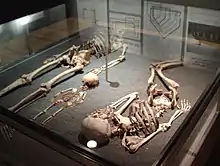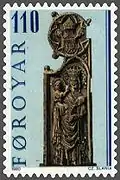National Museum of the Faroe Islands
The National Museum of the Faroe Islands (Faroese: Tjóðsavn Føroya) is the national museum of the Faroe Islands, located in Tórshavn.

The Museum on Brekkutún 6
The National Museum of the Faroe Islands has exhibitions in the museum building on Brekkutún 6 in Tórshavn. The galleries tell the natural and cultural history of the Faroe Islands. This goes back to the origin of the landmass dating back 65 mya, through the pre-settlement era and the culture etc. from the Viking Ages and the Middle Ages. Displays include rocks and minerals, birds, plants and fish, as well as items from the farming live and the maritime live in the Faroe Islands. The famous Kirkjubøstólarnir, which are parts of the original benches from the Ólavskirkjan (St. Olav's Church) of Kirkjubøur are amongst the most valued cultural items of the National Museum on Brekkutún 6. These were in Denmark for many years but have now returned to the Faroe Islands.[1]
Heima á Garði in Hoyvík
Heima á Garði is a farmhouse in Hoyvík, near Tórshavn. The farmhouse is now a part of the National Museum of the Faroe Islands. The main building was built around 1812, but it is furnished like Faroese houses were in 1920s. The museum is an outdoors museum with all the buildings and tools etc. which belonged to the farmhouse.
The pew ends
The medieval pew ends from Saint Olav's church at Kirkjubøur (mentioned above) featured in three series of Faroese stamps, engraved by Czeslaw Slania.
Faroese stamps 1980:
 FR 49: Maria and Baby Jesus
FR 49: Maria and Baby Jesus FR 50: St. John the Baptist
FR 50: St. John the Baptist FR 51: St. Peter
FR 51: St. Peter FR 52: St. Paul
FR 52: St. Paul
Faroese stamps 1984:
 FR 087: Saint John, the Evangelist.
FR 087: Saint John, the Evangelist. FR 088: Saint James.
FR 088: Saint James. FR 089: Saint Thomas.
FR 089: Saint Thomas. FR 090: Saint Judas Thaddeus.
FR 090: Saint Judas Thaddeus.
Faroese stamps 2001:
 FR 379: Saint Andrew.
FR 379: Saint Andrew. FR 380: Saint Bartholomew.
FR 380: Saint Bartholomew. FR 381: Unidentified apostle.
FR 381: Unidentified apostle. FR 382: Unidentified apostle.
FR 382: Unidentified apostle.
See also
References
- Patursson.com Archived 2011-07-15 at the Wayback Machine
External links
- tjodsavnid.fo (Official website of the National Museum of the Faroe Islands).